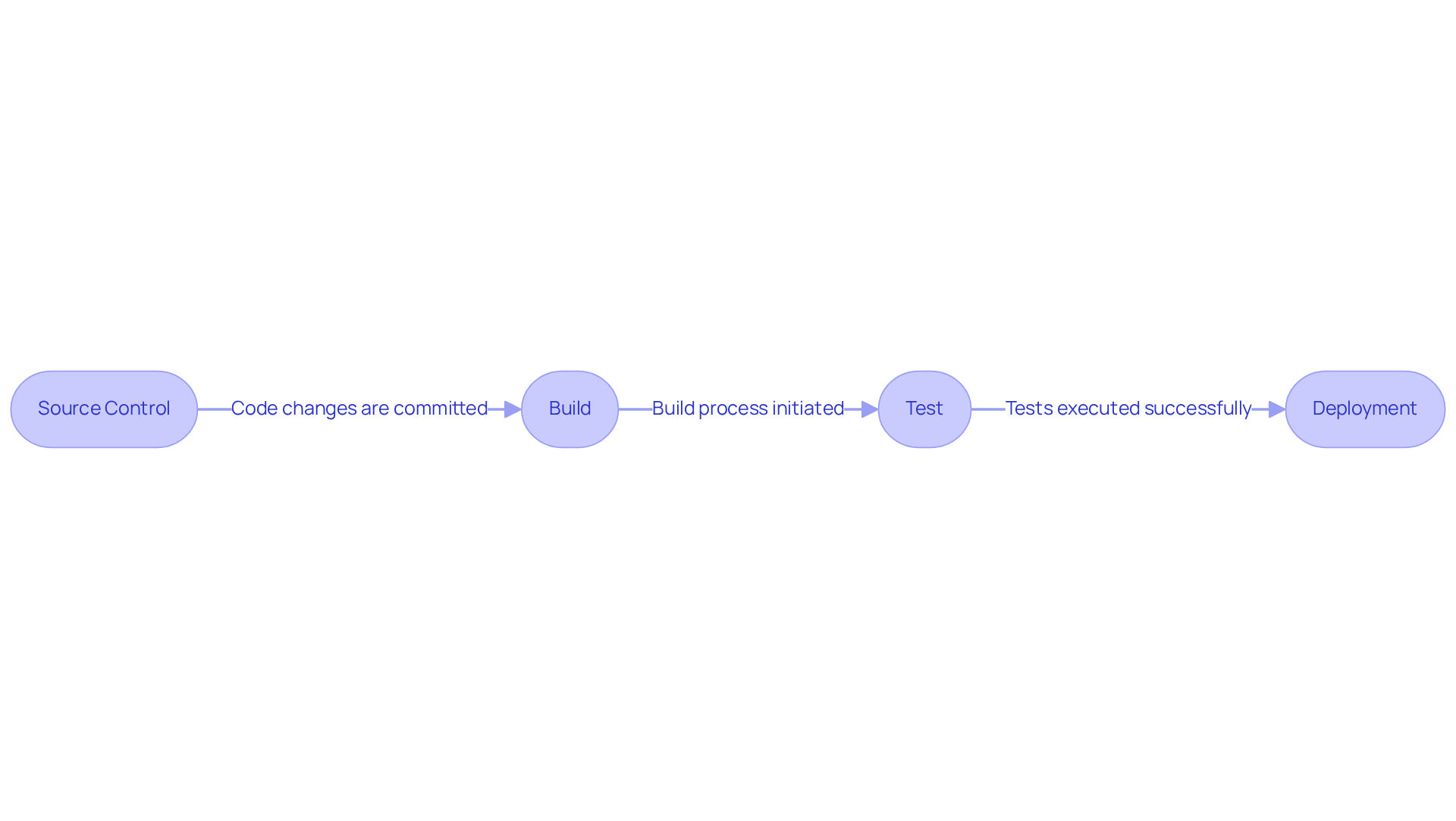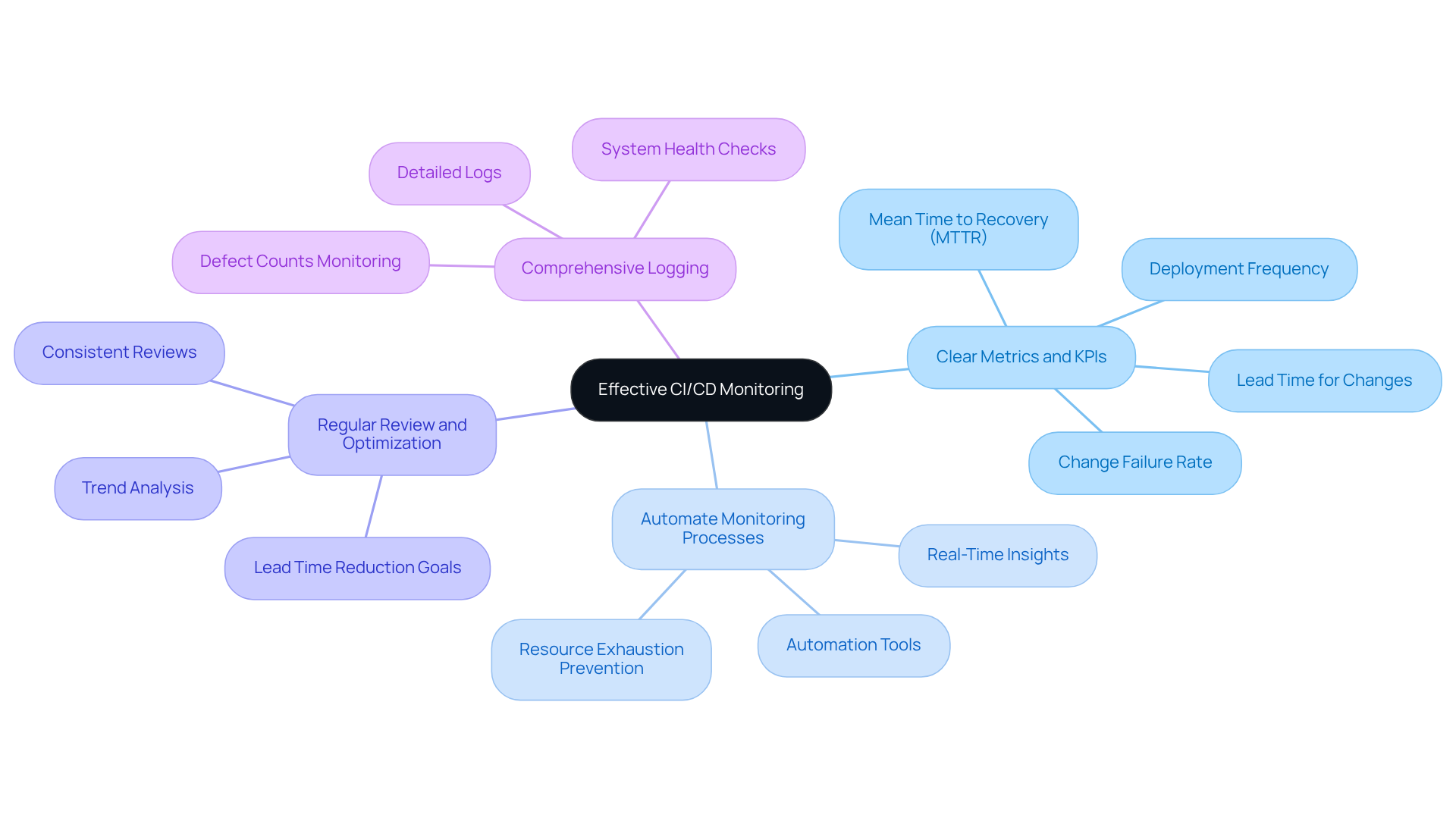Overview
The title "5 Strategies for Effective AI CI Pipeline Monitoring" highlights the importance of enhancing the monitoring of AI Continuous Integration (CI) pipelines. This article outlines several key strategies that can significantly improve monitoring practices. These include:
- Establishing clear metrics and KPIs
- Automating monitoring processes
- Conducting regular reviews
- Implementing comprehensive logging
- Leveraging automation tools
Each of these strategies is essential for maintaining the performance and reliability of AI systems within CI/CD frameworks. By adopting these approaches, organizations can ensure their AI systems operate efficiently and effectively.
Introduction
Effective monitoring of AI Continuous Integration (CI) and Continuous Delivery (CD) pipelines is becoming increasingly crucial as organizations strive for faster and more reliable software delivery. With the complexities introduced by AI technologies, teams face unique challenges that can jeopardize the integrity and performance of their systems.
How can organizations ensure that their AI models remain robust and accurate amidst these challenges? This article delves into five essential strategies that not only enhance monitoring practices but also address the specific risks associated with AI in CI/CD environments. The exploration of best practices and automation tools will provide insights into maintaining a high-performing CI/CD pipeline.
Understand CI/CD Pipeline Fundamentals
Continuous Integration (CI) and Continuous Delivery (CD) are essential practices that automate the software development lifecycle, addressing the challenges developers face in ensuring efficiency and reliability. Have you ever encountered obstacles in integrating code changes? CI tackles this by automating the testing and integration of these changes into a shared repository, while CD ensures that these updates are deployed to production seamlessly.
Understanding the phases of a CI/CD pipeline—source control, build, test, and deployment—is crucial for effective AI CI pipeline monitoring. Each stage presents unique challenges and opportunities for optimization, emphasizing the need for a comprehensive grasp of their interconnections.
As Sacha Labourey points out, mastering these fundamentals is vital for organizations aiming to leverage CI/CD practices effectively, as they significantly impact software delivery speed and quality. Furthermore, successful implementations of CI/CD pipelines demonstrate that organizations can achieve faster release cycles and enhanced code quality. This makes it imperative for teams to prioritize mastering these stages as we move into 2025 and beyond.

Identify AI-Specific Risks in CI/CD Monitoring
AI models are susceptible to drift over time, which can significantly impair their performance if AI CI pipeline monitoring is not conducted diligently. This drift often arises from changing input data or altering model assumptions, requiring a strong oversight framework. Effective oversight should encompass checks for model accuracy, data integrity, performance metrics, and AI CI pipeline monitoring. For instance, a study by Vela et al. indicates that 91% of machine learning models experience degradation over time, underscoring the critical need for continuous oversight.
Furthermore, setting up notifications for significant variations in these areas allows teams to react quickly to possible problems, thus ensuring that AI CI pipeline monitoring elements within the continuous integration and delivery process stay dependable and efficient. Data quality issues further complicate this landscape; nearly 70% of organizations have made significant decisions based on inaccurate financial data, highlighting the risks associated with poor data governance.
By implementing automated data quality profiling tools like Dedupely and OpenRefine, along with regular audits, organizations can proactively address these challenges, enhancing the overall integrity of their AI systems. Neglecting these practices can lead to severe consequences, including inaccurate predictions and misguided business decisions.

Implement Best Practices for Effective CI/CD Monitoring
To implement effective AI CI pipeline monitoring, it is crucial to consider several best practices that can enhance the performance of your pipeline.
-
Establish Clear Metrics and KPIs: What does success look like for your continuous integration and continuous delivery pipeline? Defining key performance indicators (KPIs) such as deployment frequency, lead time for changes, and mean time to recovery (MTTR) is essential for evaluating performance in AI CI pipeline monitoring. High-performing groups typically aim for lead times measured in hours, while lower-performing units may take days or weeks to recover from failures. Notably, high-performing teams experience change failure rates between 0-15 percent, providing a clearer context for success metrics in CI/CD oversight.
-
Automate Monitoring Processes: Have you considered how automation can streamline your monitoring? Utilizing tools that automate the collection and analysis of metrics reduces manual mistakes and ensures consistent, dependable oversight. For instance, sophisticated observation methods such as complete workflow tracking can improve transparency and pinpoint obstacles in real-time. It's important to note that 63% of pipeline failures are caused by resource exhaustion, emphasizing the critical role of AI CI pipeline monitoring in preventing these failures.
-
Regular Review and Optimization: Are you regularly reviewing your monitoring data? Scheduling consistent reviews allows teams to identify trends and areas for improvement proactively. This approach ensures that deployment frequency aligns with business objectives and that lead times are continually optimized. Teams should aim to reduce lead time from 14 days to 7 days before targeting less than 1 day, establishing a clear objective for continuous integration and continuous delivery processes.
-
Comprehensive Logging: How visible is your pipeline's operation? Implementing comprehensive logging provides essential visibility into the operations of AI CI pipeline monitoring. Detailed logs can help diagnose issues and understand the context of failures, enabling quicker resolutions. By monitoring metrics like defect counts and code coverage, teams can gain insights into the status of their continuous integration and delivery processes and make informed choices for improvements. As Nimrod Kramer highlights, system health checks guarantee that infrastructure and resources are functioning as anticipated, underscoring the significance of logging and oversight.

Leverage Automation Tools for Enhanced Monitoring
Automation tools are essential for enhancing continuous integration and delivery monitoring. Developers often encounter challenges in maintaining code quality and system performance. How can we address these issues effectively? Kodezi offers several solutions that streamline the CI/CD process.
-
Integrate Monitoring Tools: By utilizing tools like Datadog, Grafana, or Prometheus, teams can gather and display vital metrics from their CI/CD processes. These tools provide immediate insights into system performance and alert teams to problems as they arise.
-
Set Up Automated Alerts: Configuring alerts for key performance indicators (KPIs) enables teams to be notified of potential issues before they escalate. Automated alerts play a crucial role in maintaining pipeline health and ensuring timely responses to failures.
-
Utilizing AI CI pipeline monitoring enables the implementation of AI-driven monitoring solutions that analyze historical data to foresee potential failures or performance degradation. This proactive approach empowers teams to tackle issues before they impact production.
-
Incorporate Automated Code Debugging: Kodezi's automated code debugging capabilities instantly identify and resolve codebase issues. This feature not only provides detailed explanations of errors but also enhances code quality by addressing performance bottlenecks, identifying security vulnerabilities, and ensuring compliance with current coding standards. Integrating automated debugging into your CI/CD pipeline significantly reduces troubleshooting time and boosts overall efficiency.
-
Enhance Code Quality with AI-Driven Testing: Kodezi's AI-driven automated builds and testing ensure adherence to best practices within your codebase. This integration optimizes performance and fortifies security compliance, making your development process more robust.
In conclusion, by leveraging these automation tools along with AI CI pipeline monitoring, developers can significantly improve productivity and code quality. Ready to enhance your CI/CD pipeline? Explore the tools available on Kodezi's platform today.

Conclusion
Effective AI CI pipeline monitoring is not merely beneficial; it is essential for ensuring the reliability and performance of software development processes. By grasping the core components of CI/CD pipelines and implementing strategic monitoring practices, organizations can significantly enhance their ability to deliver high-quality software efficiently. Furthermore, the integration of automation tools and best practices streamlines monitoring and mitigates risks associated with AI model drift and data quality issues.
Key strategies outlined in this discussion include:
- Establishing clear metrics and KPIs
- Automating monitoring processes
- Conducting regular reviews
- Leveraging comprehensive logging
Each of these elements plays a crucial role in maintaining the health of CI/CD pipelines, enabling teams to respond proactively to potential issues. In addition, the implementation of automation tools further enhances monitoring capabilities, allowing for real-time insights and quicker resolutions to problems.
In a rapidly evolving technological landscape, prioritizing effective AI CI pipeline monitoring is not just a best practice—it's a necessity. Organizations that embrace these strategies will improve their software delivery cycles and foster a culture of continuous improvement and innovation. By taking action now and exploring the available tools, teams can ensure that their CI/CD processes are robust, responsive, and ready to meet the challenges of the future.
Frequently Asked Questions
What are Continuous Integration (CI) and Continuous Delivery (CD)?
Continuous Integration (CI) and Continuous Delivery (CD) are practices that automate the software development lifecycle, helping developers overcome challenges related to efficiency and reliability in integrating code changes and deploying updates.
How does Continuous Integration (CI) help developers?
CI automates the testing and integration of code changes into a shared repository, addressing obstacles developers face when integrating these changes.
What role does Continuous Delivery (CD) play in the software development process?
CD ensures that updates are deployed to production seamlessly, facilitating a smooth transition from development to deployment.
What are the main phases of a CI/CD pipeline?
The main phases of a CI/CD pipeline are source control, build, test, and deployment.
Why is understanding the CI/CD pipeline phases important?
Understanding these phases is crucial for effective AI CI pipeline monitoring, as each stage presents unique challenges and opportunities for optimization.
What impact do CI/CD practices have on software delivery?
Mastering CI/CD practices significantly impacts software delivery speed and quality, allowing organizations to achieve faster release cycles and enhanced code quality.
What should organizations prioritize as they move into 2025 regarding CI/CD?
Organizations should prioritize mastering the stages of the CI/CD pipeline to leverage these practices effectively for better software delivery outcomes.




